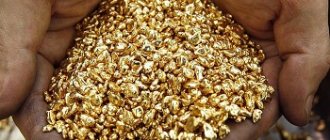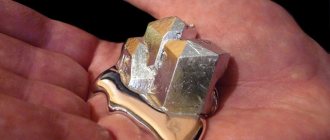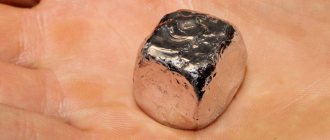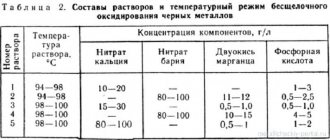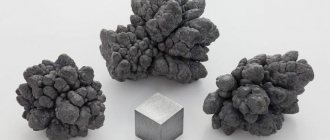Gallium melts at just 29.76°C, so it melts even in your hand. At temperatures close to room temperature, three more metals melt: mercury, cesium and rubidium. But due to their high toxicity or reactivity, unlike gallium, they cannot be handled.
A brief excursion into history
What is the name of the metal that melts in your hand?
As noted above, such a material is known as gallium. Its theoretical existence was predicted back in 1870 by a domestic scientist, the author of the table of chemical elements, Dmitry Mendeleev. The basis for the emergence of such an assumption was his study of the properties of numerous metals. At that time, not a single theorist could have imagined that the metal that melts in the hands exists in reality. The possibility of synthesizing an extremely fusible material, the appearance of which Mendeleev predicted, was proven by the French scientist Emile Lecoq de Boisbaudran. In 1875, he succeeded in isolating gallium from zinc ore. During experiments with the material, the scientist obtained a metal that melts in his hands.
It is known that Emile Boisbaudran experienced significant difficulties in isolating a new element from zinc ore. During his first experiments, he managed to extract only 0.1 grams of gallium. However, even this was enough to confirm the amazing property of the material.
Predicted Element
When Dmitry Mendeleev formulated his periodic law and compiled the periodic table, many metals were not yet known to science.
This, however, did not stop the chemist from building his periodic system, leaving empty cells for elements not yet discovered. These "blank spots" were soon filled. One of these elements predicted by Mendeleev will be discussed today.
Meet gallium, number 31 in the table. The third group is a low-melting metal, similar in properties to aluminum and silicon. Mendeleev not only described the properties of this metal in sufficient detail, but also indicated its atomic weight with almost one hundred percent accuracy.
Where is gallium found in nature?
Gallium is one of the elements that does not occur as ore deposits. The material is very dispersed in the earth's crust. In nature, it is found in extremely rare minerals such as gallite and zengeite. During laboratory experiments, a small amount of gallium can be isolated from the ores of zinc, aluminum, germanium, and iron. Sometimes it is found in bauxite, coal deposits, and other mineral deposits.
Receipt
To obtain metal gallium, the rare mineral gallite CuGaS2 (mixed copper and gallium sulfide) is often used. Traces of it are constantly found with sphalerite, chalcopyrite and germanite. Much larger quantities (up to 1.5%) were found in the ash of some coals. However, the main source of gallium is the solutions of alumina production during the processing of bauxite (usually containing minor impurities (up to 0.1%)) and nepheline. Gallium can also be obtained by processing polymetallic ores and coal. It is extracted by electrolysis of alkaline liquids, which are an intermediate product of processing natural bauxite into technical alumina. The concentration of gallium in the alkaline aluminate solution after decomposition in the Bayer process: 100-150 mg/l, by sintering method: 50-65 mg/l. By these methods, gallium is separated from most of the aluminum by carbonization, concentrating in the last fraction of the sediment. Then the enriched sediment is treated with lime, gallium goes into solution, from where the rough metal is released by electrolysis. Contaminated gallium is washed with water, then filtered through porous plates and heated in a vacuum to remove volatile impurities. To obtain gallium of high purity, chemical (reactions between salts), electrochemical (electrolysis of solutions) and physical (decomposition) methods are used. In a very pure form (99.999%), it was obtained by electrolytic refining, as well as by the reduction of carefully purified GaCl3 with hydrogen.
Areas of application
Gallium has not yet found application in industry.
This is due to the widespread use of aluminum, which has similar properties in solid form. Despite this, gallium looks like a promising material because it has excellent semiconductor properties. This metal can potentially be used for the production of transistor elements, high-temperature current rectifiers, and solar panels. Gallium looks like an excellent solution for making optical mirror coatings that will have the highest reflectivity. The main obstacle to the use of gallium on an industrial scale remains the high cost of its synthesis from ores and minerals. The price per ton of such metal on the world market is more than $1.2 million.
To date, gallium has found effective use only in the medical field. The metal in liquid form is used to slow down bone loss in people suffering from cancer. It is used to quickly stop bleeding in the presence of extremely deep wounds on the body of victims. In the latter case, blockage of blood vessels by gallium does not lead to the formation of blood clots.
Explanation of processes
Sodium is a very active metal; it is capable of displacing hydrogen from water. The reaction of sodium and water is often accompanied by an explosion. If a small piece of sodium is thrown into a crystallizer with water and an acid-base indicator, the sodium will quickly run across the surface of the liquid. At the same time, it will melt, turning into a beautiful “bead” that can even catch fire!
Why does sodium run
When interacting with water, hydrogen is released, which pushes sodium to “escape.”
Why does sodium melt and catch fire?
The reaction of sodium with water is accompanied by the release of a huge amount of heat - because of this, the metal melts. This reaction energy is enough to ignite the released hydrogen!
Why do the colors of solutions change?
Phenolphthalein, indigo carmine and thymol blue are acid-base indicators, that is, substances that change their color depending on the pH of the medium. When sodium reacts with water, sodium hydroxide is formed, which is a very strong base - this is how the environment becomes alkaline. Phenolphthalein changes color from colorless to crimson, indigo carmine from blue to green, and thymol blue from yellow to blue.
Source
Interesting experiments with gallium
As noted above, gallium is a metal that melts in the hands.
Since the temperature required for the material to transform into a liquid state is slightly more than 29 °C, it is enough to hold it in your palms. After some time, the initially solid material will begin to melt literally before our eyes. A rather fascinating experiment can be carried out with the solidification of gallium. The presented metal tends to expand during solidification. To conduct an interesting experiment, it is enough to place liquid gallium in a glass vial. Next you need to start cooling the container. After some time, you will notice how metal crystals begin to form in the bubble. They will have a bluish color, as opposed to the silvery tint that is characteristic of the material in its liquid state. If cooling is continued, the crystallizing gallium will eventually rupture the glass vial.
The concept of fusible metals/alloys
Fusibility is a flexible concept, this is especially true for industry. In chemistry, fusible elements are considered to be elements of the group of metals + their alloys, the melting point of which is below the threshold of 1000 degrees Celsius.
If the melting point of a metal exceeds 1,500 degrees Celsius, it is usually classified as refractory. The diagram above makes it clear where each metal should go.
Please note: the minimum melting point of mercury is 39 degrees. It is thanks to this physical property that we can observe a chemical element in a constantly liquid state.
Now let's look at low-melting alloys. For the most part, these are eutectic type alloys, the peak melting point of which does not exceed 232 degrees Celsius. The production of low-melting alloys is based on low-melting metals - tin, bismuth, thallium, gallium and others.
Scientists managed to achieve -78 degrees as the minimum melting point for the Soviet alloy, which consists of 12% sodium, 47% potassium and 41% cesium. The disadvantage of the alloy is its reaction with water. The closest competitor is amalgam. A toxic alloy of mercury and thallium that remains liquid down to a temperature of -61 degrees Celsius.
Scope of application of low-melting metals/alloys:
- energy industry and mechanical engineering. The main direction is the creation of liquid metal-type heat carriers;
- injection molding industry;
- as a basis for temperature sensors, which is important in fire safety systems;
- as a basis for the development of thermometers;
- as a repair material in vacuum technologies;
- solders, fuses and other small items in microelectronics;
- medical direction. The same prosthetics;
- like metal lubricant.
Low melting point is a basic property that is required from low-melting metals and alloys. Secondary parameters that are taken into account in various fields of use are density, tensile strength and chemical inertness.
How does Archimedes' force work?
Since the Archimedes force acting on a body depends on the volume of its immersed part and the density of the medium in which it is located, it is possible to calculate how a particular body will behave in a certain liquid or gas.
If the density of a body is less than the density of a liquid or gas, it will float on the surface.
If the densities of the body and the liquid or gas are equal, the body will be in indifferent equilibrium in the thickness of the liquid or gas.
If the density of a body is greater than the density of liquid or gas, it will sink to the bottom.
Archimedes' force in liquid: why ships don't sink
The ship's hull is filled with air, so the overall density of the ship is less than the density of water, and the Archimedes force pushes it to the surface. But if the ship gets a hole and the space inside fills with water, then the overall density of the ship will increase and it will sink.
Submarines have special tanks that are filled with water or compressed air, depending on whether you need to go deeper or rise closer to the surface. Fish use the same principle when filling a special organ, the swim bladder, with air.
The buoyant force does not act on a body that fits tightly to the bottom. This is taken into account when raising sunken ships. First, the vessel is slightly raised, allowing water to penetrate under it. Then the water pressure begins to act on the ship from below.
But in order to raise the ship to the surface, it is necessary to reduce its density. Of course, the air in the case that has received a hole will not be retained. Therefore, it is filled with some light substance, for example, polystyrene foam balls.
What metals run on water?
Light alkali metals such as lithium, sodium, potassium. Their density is less than that of water, that is, less than 1 g/cm3. And besides, they react with water to form alkali and release hydrogen.
Running has a rather detrimental effect on joints, especially on the skeleton of people with a fairly large weight, due to excess weight or high growth. Running is also a stressful activity for people of small stature - during running, internal organs experience a strong “shock”, which can affect both general well-being and the functions of each organ separately. So, if a person has problems with joints, then running is strictly contraindicated for him. Healthy people must warm up before running to reduce its consequences.
If you do not want to subject your body to running loads, then walking is quite suitable for you, but, both for the general strengthening of the body and for developing endurance for training, it is better to sign up for a gym or, if this is not possible, work out at home, doing both strength training and strength training. as well as cardio training.
Archimedes' force formula
Any object immersed in water experiences a buoyant force equal to the weight of the liquid it displaces. Thus, the weight of an object immersed in water will differ from its weight in air to a lesser extent. The difference will be equal to the weight of the displaced water.
The higher the density of the medium, the lower the weight. That is why, when immersed in water, we can easily lift another person.
The buoyancy force depends on three factors:
- density of liquid or gas (p);
- free fall acceleration (g);
- volume of the immersed part of the body (V).
Comparing these data, we get the formula:
"Eureka!" Discovery of Archimedes' law
One day, King Hieron II of Syracuse turned to Archimedes with a request to establish whether his crown was really made of pure gold, as the jeweler claimed. The ruler suspected that the master had pocketed some of the precious metal and partially replaced it with silver.
At that time, there was no way to determine the chemical composition of a metal alloy. The problem puzzled the scientist. Thinking about it, he went to the bathhouse and lay down in a bathtub filled to the brim with water. When some of the water poured out, Archimedes had an epiphany. Such that the scientist ran naked into the street and shouted “Eureka!”, which in ancient Greek means “Found!”
